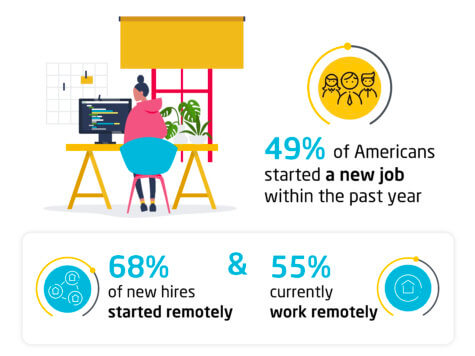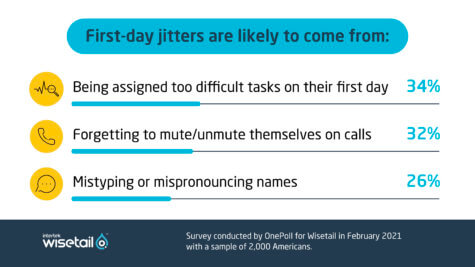Survey shows that 39% of workers would prefer a pay cut if it meant they wouldn’t be required to return to the workplace again.
NEW YORK — If you think working remotely is a fad that will leave with the coronavirus pandemic, think again! Over a third of Americans currently working remotely would quit on the spot if they had to go into the office, according to a new survey.
The poll of 2,000 Americans reveals that nearly half (49%) started a new job within the past year and 55 percent currently work remotely. Nearly four in 10 remote workers (39%) would rather take a pay cut than step foot in an office. For comparison, 45 percent of in-person employees say they wouldn’t give up the extra dough and can power through being surrounded by cubicles and co-workers.
Commissioned by Wisetail and conducted by OnePoll, the study asked both types of employees to share their thoughts on a number of different issues. Researchers find the majority of remote workers (59%) feel like their company puts them first. Meanwhile, 49 percent of in-office workers hold the same belief.
In addition to feeling like a priority, more remote workers also feel like their company has made strides to improve employee treatment (52% vs. 39%), relax sick leave policies (57% vs. 48%), and offer better health insurance options (43% vs. 31%) in comparison to on-site workers.
Finding the right fit, even from home
 While remote workers take nine days to get fully acclimated to their new job, in-office workers say they only need eight. Still, 48 percent of remote workers believe it’s easier to get through the onboarding process remotely than in-person. Meanwhile, only 30 percent of in-office workers believe in remote onboarding. Overall, more than half the poll (51%) agree that every company needs to have remote working options available, even if they plan on working at the office.
While remote workers take nine days to get fully acclimated to their new job, in-office workers say they only need eight. Still, 48 percent of remote workers believe it’s easier to get through the onboarding process remotely than in-person. Meanwhile, only 30 percent of in-office workers believe in remote onboarding. Overall, more than half the poll (51%) agree that every company needs to have remote working options available, even if they plan on working at the office.
“An effective people strategy includes the ability to communicate and develop culture digitally alongside traditional training and onboarding. Although we’re further apart, we have a need to be closer than ever. Creating a digital community is vital to remote worker success,” says Ali Knapp, president of prominent LMS and LXP software provider Wisetail, in a statement.
When deciding whether or not to take a new job, 69 percent of respondents said benefits are a major deciding factor. Benefit must-haves include health insurance (55%), dental insurance (33%), retirement options (29%), and vision insurance (24%).
At the opposite end of things, employees don’t have an interest in their company sending them remote working tools (11%), having a strong sick day policy in place (11%), or having stock or equity options (10%).
First day jitters are the same all over
 Starting a new job while working remotely can be a daunting task. Nearly seven in 10 (68%) new hires within the past year started their work while at home.
Starting a new job while working remotely can be a daunting task. Nearly seven in 10 (68%) new hires within the past year started their work while at home.
Just as many (69%) spoke directly with their company’s CEO during the onboarding process for their new position. On the other hand, 52 percent of in-office employees did not have the same chance during their orientation process.
Three out of five remote new hires (63%) feel nervous on their first day working a new job. The biggest first-day jitters came from being assigned difficult tasks on their first day (34%), forgetting to mute/unmute themselves on calls (32%), and mistyping or mispronouncing names (26%).
“First days always include a level of uneasiness and shifting to remote on boarding can exacerbate this experience. Today companies realize that investing in their people strategies including — learning, development, communication, and talent management — are key to overarching business strategies. As the world changes, employees are choosing to work with companies that invest in their people in the form of corporate responsibility, and that includes employee health and wellness. Another component of this is supporting employees in a remote setting, which includes investing in technology that strengthens the remote employee experience,” Knapp explains.
